The US dollar outperformed all the other major currencies yesterday, while equities slid after Fed Chair Powell appeared more hawkish than anticipated. He confirmed expectations over a March hike and hinted that they could continue with more lift-offs than they projected in December.
Ahead of the Fed, we also had a BoC decision, with officials of this bank refraining from pushing the hike button, disappointing those expecting such a move.
USD Rallies, Equities Slide After the Fed Appears More Hawkish Than Expected
The US dollar traded higher against all the other major currencies on Wednesday and during the Asian session Thursday. It gained the most versus AUD, NZD, and CAD, in that order, while it eked out minuscule gains versus GBP.
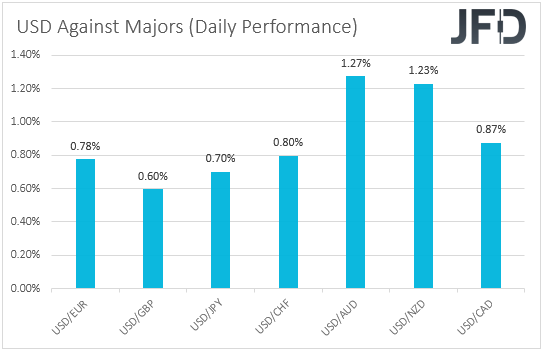
Yesterday, the main event was the FOMC decision, and a strong dollar, combined with the fact that the risk-linked currencies were the main losers, suggests that the outcome was more hawkish than anticipated. This is also evident by the performance in the equity world.
Ahead of the decision, European indices traded in the green, with Wall Street opening in a recovery mode as well. However, all three of its leading indices came under selling interest in the aftermath of the Fed decision, with both the Dow Jones Industrial Average and the S&P 500 dipping into the negative territory.
The NASDAQ finished virtually unchanged. The negative appetite rolled over into the Asian session today.
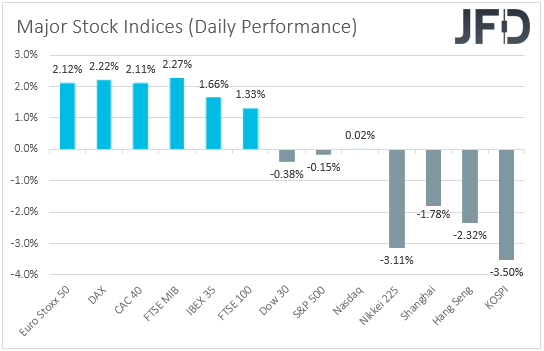
The FOMC decided to keep interest rates unchanged as was widely anticipated, and the statement warned they would soon begin raising interest rates to combat persistent inflation, something that did not come as a surprise either.
So, the reaction to that was some gains in equities. However, market participants were unable to hold onto those gains as Chair Powell’s press conference had a more hawkish flavor. The Chief said,
“The Committee is of a mind to raise the federal funds rate at the March meeting assuming that the conditions are appropriate for doing so. Inflation has probably gotten a bit worse since the last meeting. To the extent that the situation deteriorates further, our policy will have to reflect that.”
So, for us, and apparently for many other participants, the message was clear: A hike is coming in March, but most importantly, there is a decent likelihood for more lift-offs this year than the December “dot plot” suggested. Indeed, according to the Fed funds futures, market participants maintained their bets over four quarter-point hikes this year.
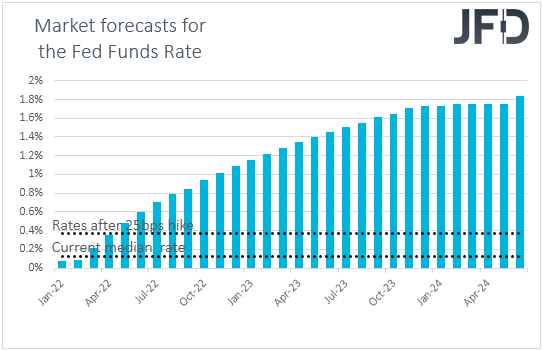
BoC Holds Rates Unchanged, Disappointing Those Expecting a Hike
Ahead of the Fed, we had another major bank deciding on interest rates, the BoC. In contrast to market expectations, officials decided to leave interest rates untouched at 0.25%, resulting in an immediate slide in the Loonie.
In the statement accompanying the decision, it was noted that the Council expects rates to increase and that the overall economic slack is now absorbed, which means that they are more likely to hit the hike button in March.
However, they again noted that the Omicron coronavirus variant is weighing on activity, with Governor Marcklem adding that hikes will not be automatic. They will take decisions at each meeting, he said. As for our view, a more hawkish-than-expected Fed could continue to benefit the US dollar for a while more and perhaps prompt more participants to sell equities.
This, combined with the less-hawkish-than-expected BoC, suggests that USD/CAD could continue drifting north for a while more. The other risk-linked currencies, Aussie and Kiwi, could also stay pressured, while the Japanese yen may keep benefiting, despite the BoJ being among the most dovish central banks.
S&P 500 – Technical View
The S&P 500 cash index traded lower yesterday, after hitting resistance at 4455, with the tumble extending today during the Asian session. Overall, the index is trading well below the prior upside support line taken from the low of Dec. 3 and below the downside resistance line drawn from the high of Jan. 13.
At the time of writing, the index is trading slightly below the 4285 barrier, which is the low of Jan. 25, the break of which could aim for the low of the day before. If the bears are not willing to stop there, we could see them pushing towards the 4135 barrier, which is the low of Jun. 21, the break of which could carry extensions towards the low of May 13, at 4035.
On the upside, we would like to see the index rising to and above the 4677 zone, marked by the high of Jan. 16. This will take the price back above the upside line taken from the low of Dec. 3 and may initially target the peak of Jan. 13, at 4745. Slightly higher lies the 4773 barrier, which, if also broken, could pave the way towards the index’s record high of 4817.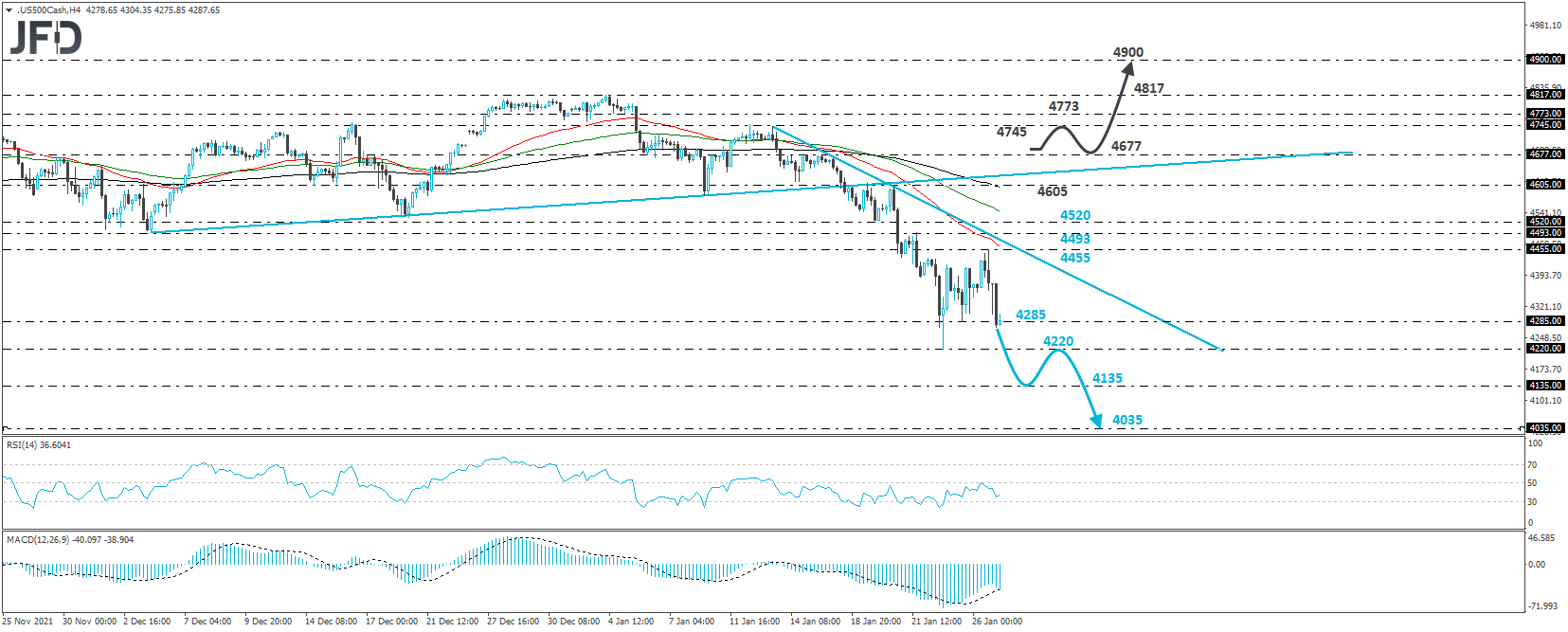
USD/CAD – Technical View
USD/CAD traded sharply higher yesterday after hitting support at 1.2560. Overall, the pair now seems to be forming higher highs and higher lows above an upside support line taken from the low of Jan. 20, which paints a positive near-term picture, in our view.
Currently, the rate looks to be headed towards the 1.2730 barrier, marked by the high of Jan. 7, the break of which could encourage advances towards the peak of the day before, at 1.2813, or the high of Dec. 29, at 1.2835. If neither barrier can provide sufficient resistance, a break higher may allow extensions towards the 1.2918 zone, marked by an intraday swing high formed on Dec. 22.
We will abandon the bullish case should the rate fall back below 1.2560. Such a move could confirm the break below the aforementioned upside line and may initially open the path towards the 1.2453 barrier, which supported Jan. 13 and 20.
If the bears are strong enough to overcome that zone this time around, we may experience extensions towards the 1.2387 level, marked by the low of Nov. 10, or the 1.2327 territory, defined as a support by the low of Oct. 29.
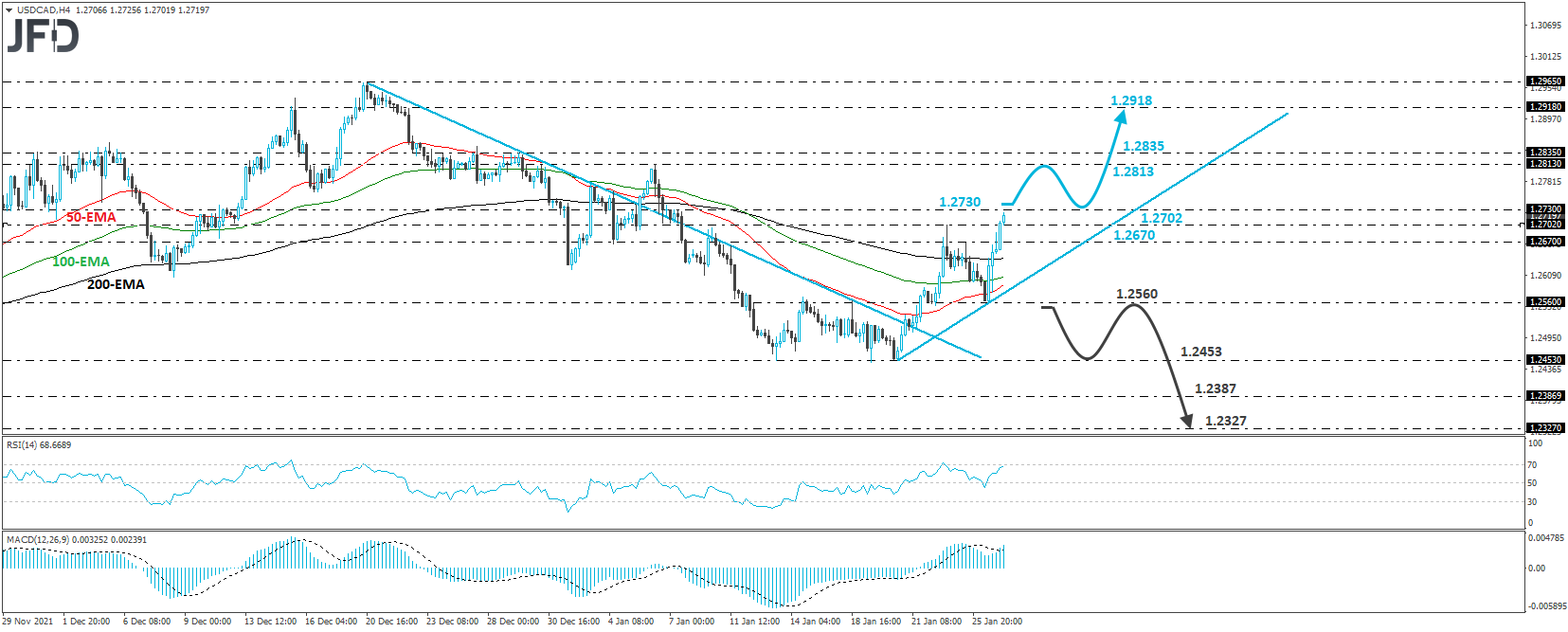
Elsewhere
During the early Asian morning, we already got New Zealand’s CPI for Q4, with the YoY rate jumping to +5.9% from +4.9%. In our view, this confirms the case for more hikes by the RBNZ, but the Kiwi seems to be more sensitive to the Fed outcome for now. Remember that it is a risk-linked currency.
Later in the day, we have the first estimate of the US GDP for Q4, which is expected to have accelerated to +5.5% QoQ SAAR from +2.3%, confirming the view that the US economy is among the best, if not the best, performing economies in the aftermath of the coronavirus outbreak.
Following a hawkish Fed yesterday, this could allow market participants to keep elevated their bets over four rate hikes by the end of the year. Tonight, during the Asian session Friday, Japan’s Tokyo CPIs for January are due to be released.
As usual, no forecast is available for the headline rate, while the core one is forecast to have slid to +0.3% YoY from +0.5%, underscoring the need for extra-loose monetary policy by the BoJ, even when other major central banks have begun to withdraw support.
